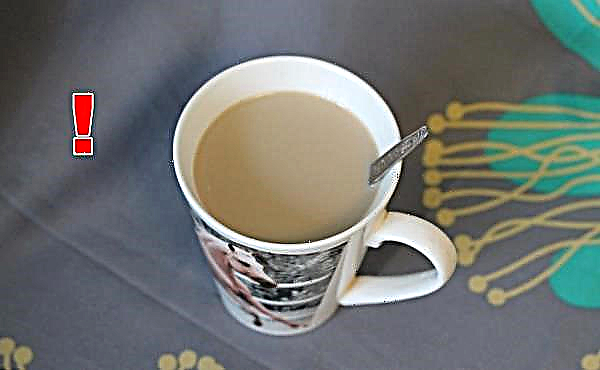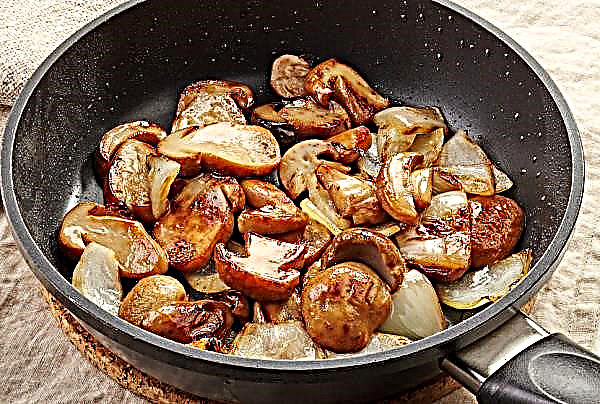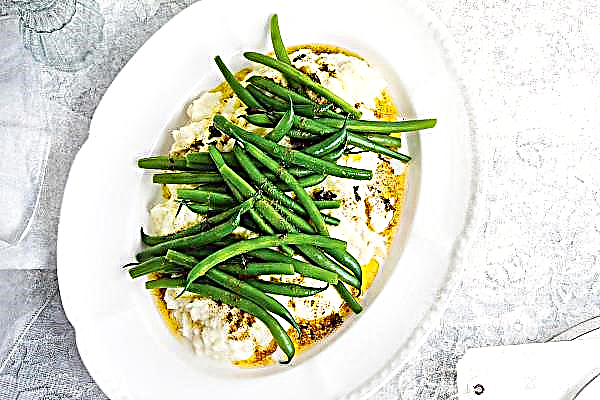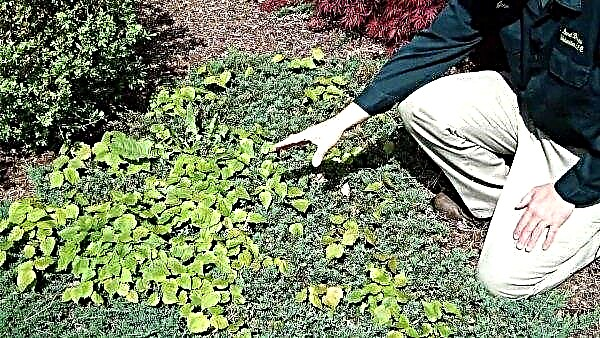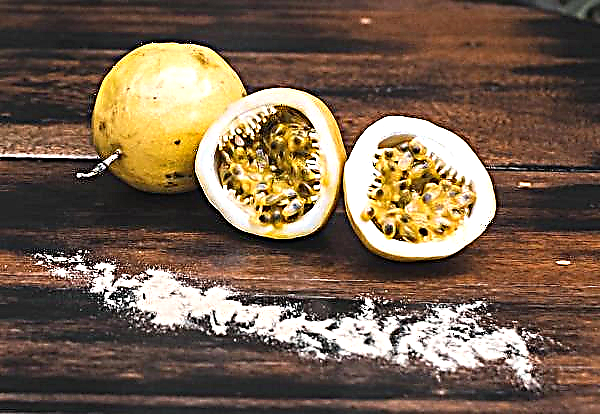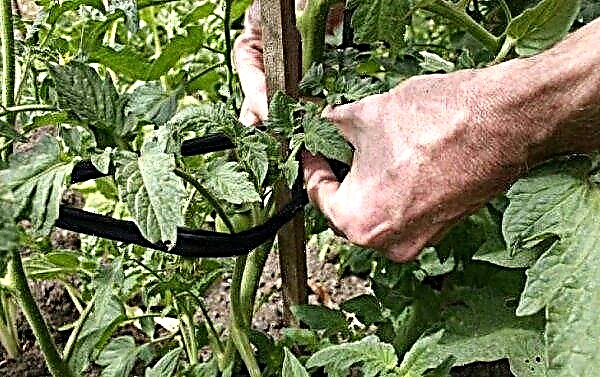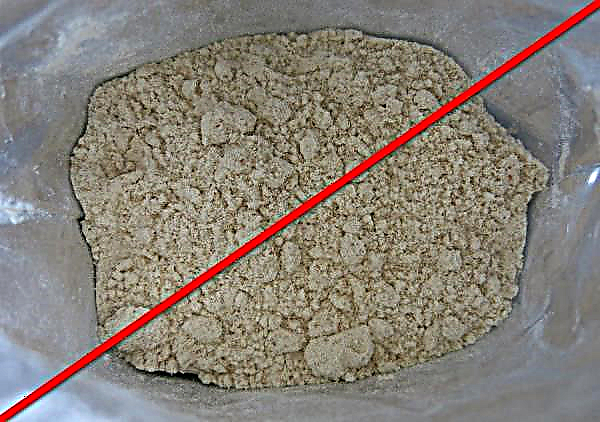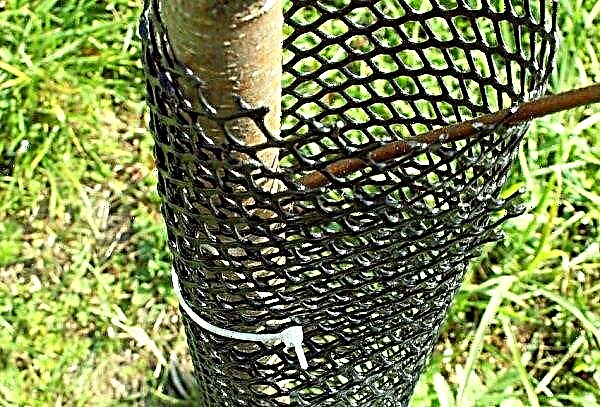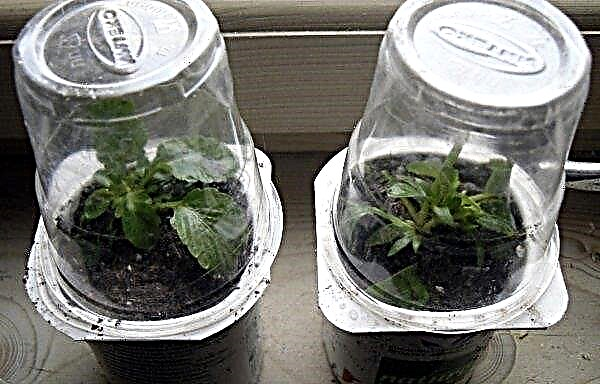In order to keep Fittonia mix at home, you need to know how to care for this plant, what are the diseases and methods of dealing with them. In the article, we consider the basic rules for growing phytonthium.
Botanical description of the plant
Fittonia mix belongs to the Acanthus family. This plant is very popular among gardeners due to its exotic appearance. The birthplace of the flower is South America.
Fittonia is a small ornamental plant, the growth of which ranges from 30 to 40 cm. The leaves of the flower in all varieties are oval. The leaf itself is dark green with veins, the colors of which can be red, white, pink and even silver. The length of the leaves is 5–10 cm. The stem of the flower is thin, light green or light brown in color, its length reaches 10 cm. Flowering phytonia is spike-shaped, yellow or cream in color.
Did you know? The plant is named after the Fitton sisters, who wrote the first textbook on botany.
Care immediately after purchase
After the purchase, it is necessary to transplant the flower into a new pot, since the soil in which Fittonia is located does not have mineral substances that contribute to further development. If the plant is purchased in the spring, you can carry out a full transplant. If you buy Fittonia at another time of the year, transshipment is used, and in the spring the flower is transplanted. Transshipment is carried out in the following way:
Transshipment is carried out in the following way:
- the substrate in which the fittonium is moistened is moistened;
- the flower is taken out of the pot;
- a new container for transshipment by a third is filled with drainage from pebbles;
- a flower with a lump of earth is placed in a new pot;
- the plant must be sprinkled with soil and compacted;
- Fittonia is watered and the remaining water is poured from the pan;
- the pot is placed in a warm place.
Conditions for successful growing at home
Fittonia is a demanding houseplant. Consider what factors must be observed for its successful cultivation at home.
Accommodation
The flower requires moderate lighting. The sun's rays should not fall on the leaves. You can place the plant in summer in the western or eastern part of the room, and in the winter, the fittonia needs to be removed away from central heating and placed on the south side of the apartment.
Temperature and humidity
In summer, the temperature for growing is + 24 ... + 27 ° С, in winter - + 18 ... + 20 ° С. In winter, temperature jumps are not allowed, since the flower can become sick. Drafts should also be avoided - if they are present, the leaves fall on the Fittonia. The flower adapts to the climate in which it is located, but you should not take it to fresh air in the summer. Fittonia mix prefers high humidity, which should be 50-60%. If the room has dry air, it can be moistened by spraying, wiping the leaves with a damp cloth, and put a container of water near the plant.
Fittonia mix prefers high humidity, which should be 50-60%. If the room has dry air, it can be moistened by spraying, wiping the leaves with a damp cloth, and put a container of water near the plant.
Further care
Further care includes proper watering, periodic pruning, soil fertilization, timely transplantation.
Watering
Watering is carried out when the top layer of the substrate is dry. It is necessary to water a flower in the summer 3-4 times, in the winter - 1-2 times a week. For irrigation use soft defended water. Water temperature should be + 15 ° С. Watering should be carried out directly under the leaves. It is necessary to monitor the soil in the pot: it must be moist.
Important! If the soil dries, the leaves will fall off the flower.
Top dressing
Fittonia fertilizer occurs from April to September. Fertilizers are used for top dressing, which can be bought in specialized stores. The dose of mineral substances should be reduced by half in comparison with what is indicated on the package.
Pruning
Pruning is performed during the active growth of the flower - in March. You need to trim in three periods with an interval of 7 days between them. Gradually cut off the old shoots in order not to harm the flower. Also, by cutting the shoots, Fittonia is rejuvenated.
Transfer
Fittonia mix refers to fast-growing indoor plants. Young flowers are transplanted annually, adults - once every three years. The transplant process is carried out in the spring - from March to April. The soil for transplantation should consist of peat, river sand and humus in a ratio of 3: 1: 1. Pots for planting fittonia should be wide, but not deep, since the root system of the flower is small.
The container for transplantation must be filled by a third with drainage from pebbles or expanded clay, you can also add moss, which will retain moisture in the soil. Then you should fill the pot with the prepared mixture, place the flower with a lump of earth in a new container. Sprout should be sprinkled with soil and compacted. Then the plant is watered, the remaining water from the pan is removed.
Propagation at home
There are three methods for breeding Fittonia at home:
- With the help of cuttings. At the time of pruning, in March, cut shoots 8 cm long are used for rooting. On the cuttings there should be two or three leaves, they are placed with the cut part in the sand, for better rooting, you can use "Kornevin". The sprout is covered for a month with a glass container, once a week it is necessary to water and air the seedlings. When propagating by cuttings, the temperature in the room should be + 25 ° C. When the root system of Fittonia is strengthened, the plant can be transplanted into a pot with a diameter of 7 cm.
- Using layering. Shoots at a distance of 5-6 cm from the apex need to be pressed to the ground, sprinkled with it a little. After the appearance of the roots, these shoots are removed and planted in a new pot.
- Division propagation. During the transplant, the flower is neatly divided into several parts and planted in pots.
Did you know? Fittonia has several useful properties - the ability to disinfect air, normalize sleep (better put in the bedroom), improve the microclimate of the room.
Growing difficulties
Non-compliance with the rules for caring for the plant contributes to the appearance of various parasites, pests and other problems:
- Spider mite. Appears with insufficient watering or dry air. To combat the parasite, the correct irrigation regime is used, the flower is sprayed with warm water, in extreme cases, the plant is treated with Actellika solution.
- Thrips. The main symptom is the appearance of silver spots on the leaves. To get rid of the pest, use such means as Actellik, Inta-Vir.
- Mealy Worms - fungal mold appears on the stem. To remove it, you need to treat Fittonia “Confidor”.
- Decay of the root system. Occurs with heavy watering. To successfully deal with the problem, you need to transplant the plant into another pot with new soil, if necessary, clearing the root system of damaged areas and old soil.
 Fittonia mix is an ornamental plant that has useful and decorative properties. Knowing the rules for caring for it, you can enjoy a unique plant for a long time, and having some idea of all the possible diseases and the difficulties of growing Fittonia, you can prevent their appearance in the future.
Fittonia mix is an ornamental plant that has useful and decorative properties. Knowing the rules for caring for it, you can enjoy a unique plant for a long time, and having some idea of all the possible diseases and the difficulties of growing Fittonia, you can prevent their appearance in the future.

